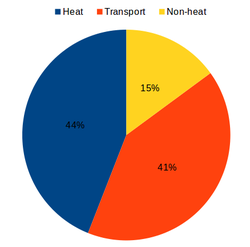sustainable energy use
 Figure 1: UK energy consumption by end use [2]
Figure 1: UK energy consumption by end use [2]
Global Heat Demand
As a concerted political effort is driven to reduce global greenhouse gas emissions, it is important that we explore all possible means of establishing a more sustainable relationship with our energy resources. Energy is required for all aspects of our daily lives, but we require more energy for heating than we do for anything else. The International Energy Agency (IEA) found that in 2009 global energy demand for heat represented 47% of the total energy demand [1]. In the UK this figure is a bit smaller, but the energy we use for heat still represent 44% of our total energy requirements (Figure 1) [2]. Getting as much of this energy as possible from sustainable sources would therefore go a long way toward helping us achieve our sustainable objectives.
As a concerted political effort is driven to reduce global greenhouse gas emissions, it is important that we explore all possible means of establishing a more sustainable relationship with our energy resources. Energy is required for all aspects of our daily lives, but we require more energy for heating than we do for anything else. The International Energy Agency (IEA) found that in 2009 global energy demand for heat represented 47% of the total energy demand [1]. In the UK this figure is a bit smaller, but the energy we use for heat still represent 44% of our total energy requirements (Figure 1) [2]. Getting as much of this energy as possible from sustainable sources would therefore go a long way toward helping us achieve our sustainable objectives.
|
Domestic Heating
The energy used within the UK for heating can broadly be split across three sectors: domestic, commercial and industrial. The domestic sector is by far the largest consumer of heat, accounting for more than 50% of total demand. Of all the energy consumed within the domestic sector, nearly 80% is used for heating (Figure 2) [2]. As of 2012, the majority of this demand for heat was being met by gas fired boilers (81%), while oil heating (9%) and electricity (7%) were contributing much smaller portions. Only 1% of heat consumed was being generated from renewable sources [3]. It is therefore clear that considerable improvements can be made by shifting to more renewable sources of heat in an effort to live more sustainably. |
References
[1] http://www.iea-shc.org/data/sites/1/publications/2012_SolarHeatingCooling_Roadmap.pdf
[2] https://www.gov.uk/government/uploads/system/uploads/attachment_data/file/190149/16_04-DECC-The_Future_of_Heating_Accessible-10.pdf
[3] https://www.gov.uk/government/uploads/system/uploads/attachment_data/file/48574/4805-future-heating-strategic-framework.pdf
[2] https://www.gov.uk/government/uploads/system/uploads/attachment_data/file/190149/16_04-DECC-The_Future_of_Heating_Accessible-10.pdf
[3] https://www.gov.uk/government/uploads/system/uploads/attachment_data/file/48574/4805-future-heating-strategic-framework.pdf

